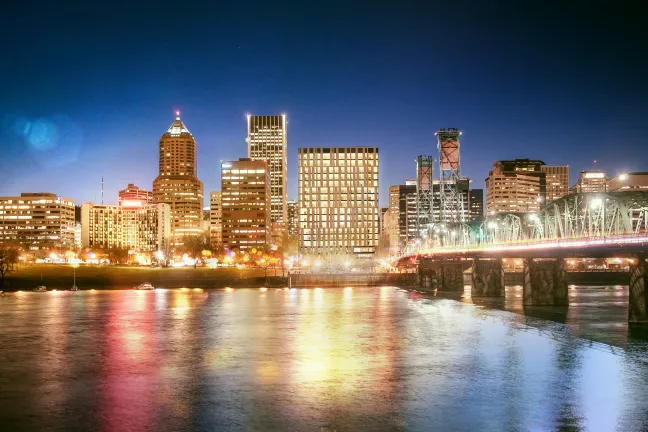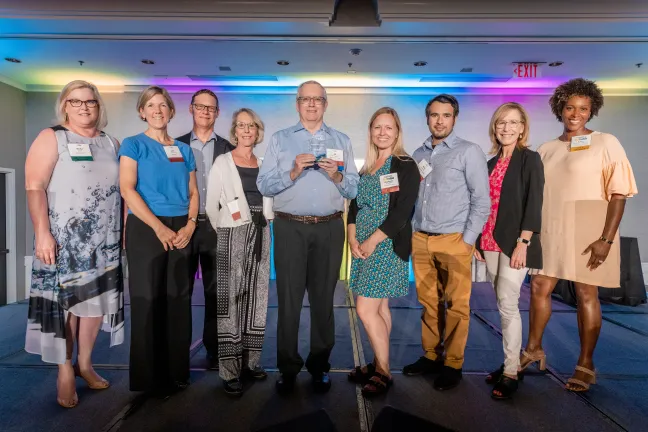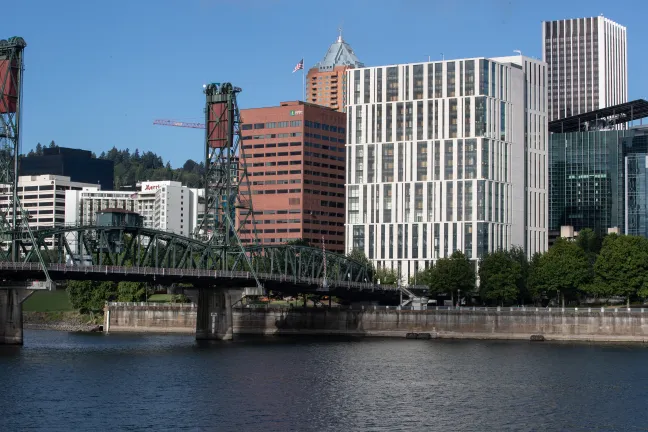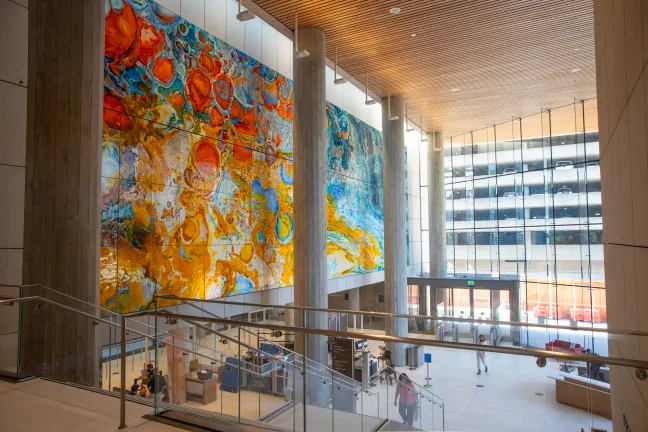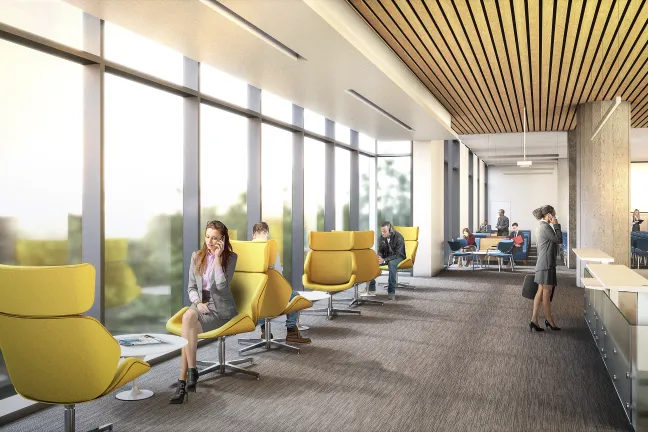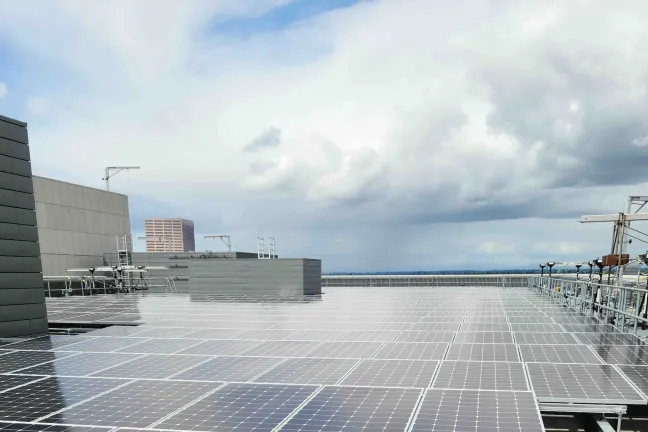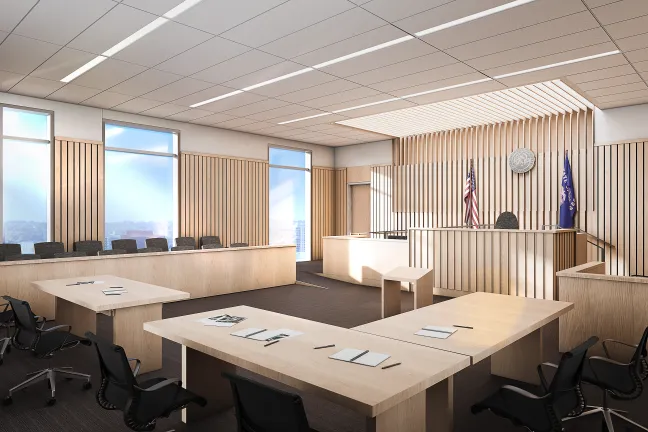The new Multnomah County Central Courthouse earned a prestigious honor Wednesday, Aug. 3, as one of the region’s most transformative building projects.
The award, presented by the Portland Business Journal, honors projects that are not only complex and visually stunning, but that are also uplifting the communities in which they're located and the people they serve.
The honor couldn’t ring more true for the distinguished 17-story Central Courthouse, which stands at the west end of the Hawthorne Bridge. Its presence has refreshed and reshaped the downtown skyline and provides a safer, seismically resilient experience for court patrons.
“Multnomah County is proud to receive this award and acknowledgment of the transformative nature of the new Multnomah County Central Courthouse,” said JD Deschamps, Multnomah County Courthouse project manager, who accepted the award on behalf of the County at a ceremony Wednesday.
“The County appreciates the support of the State in funding the project, as well as our design and construction partners, SRG Partnership and Hoffman Construction.”
The new Multnomah County Central Courthouse was decades in the making, with many studies pointing to the pressing need to replace the seismically and functionally obsolete courthouse on Southwest 4th Avenue and Main Street. After critical investments from the County and the State, the County formally broke ground on the project in October 2016.
The project team set and met aggressive workforce goals, including employing and paying living wages for more than 2,500 workers. The project also achieved a 30% apprenticeship rate, surpassing its original 20% goal.
It met benchmarks for workforce diversity, with minority-owned, women-owned, service-disabled veteran-owned and emerging small businesses making up 35% of the workforce, which translated to more than $72 million in revenue for 124 firms. The Project Labor Agreement included aggressive goals for participation by women and minority workers: Women worked 10.3% of all trades worker hours, while men of color worked 27.8%.
Workers removed 15,000 cubic yards of soil; poured over 17,000 cubic yards of concrete; erected 700 floor-by-floor concrete columns; installed 4,500 exterior windows; and completed a tremendous amount of mechanical, electrical and plumbing work. After more than 1.5 million hours worked by the trades, the new courthouse emerged as a state-of-the-art, modern building on the west bank of the Willamette River.
The goal of the Central Courthouse project was to not only provide a more efficient and seismically safer courthouse designed to endure the strength of an earthquake, but also to enhance civic engagement, inspire confidence in the justice system and provide a restorative experience for court patrons.
Just inside the three-story atrium, visitors are greeted by a 75-by-25 foot, kiln-formed glass art installation — inspired by the variety of people who pass through the courthouse doors and their myriad journeys. Artwork is placed throughout the interior and exterior of the building, including steel imagery panels outside the building that utilize both abstract and realistic techniques to depict a representative history of Multnomah County. A bilingual court navigator who helps guide visitors to their destinations, staffs the information desk in the lobby. The courthouse’s second floor offers a centralized customer service area and ample technology to allow for virtual proceedings, which proved to be essential amid the challenges presented by COVID-19.
The courthouse also incorporates innovative and sustainable features, including a clever solution that shuffles energy generated by the courthouse to the neighboring Hawthorne Bridge, which is also run by Multnomah County. Solar power, produced by photovoltaic panels on the courthouse roof, feeds into a circuit that services the bridge and helps offset energy use from bridge lifts and lighting. The courthouse meets the American Institute of Architects’ 2030 challenge goals around the creation of carbon-neutral buildings. The courthouse is certified LEED Gold for sustainable design.
This year’s awards honored projects completed between 2019 and 2021, during the height of the COVID-19 pandemic. The Central Courthouse, which opened in fall 2020, was one of 13 transformative projects honored at the award ceremony Aug. 3. Other buildings receiving honors included the new Kellogg Middle School in Southeast Portland, Catholic Charities’ Chiles House affordable apartments on Southeast Powell Boulevard, and the new Fora Health Treatment and Recovery Center in Southeast Portland.
"Thanks to the hard work of our project teams, the Central Courthouse will benefit and serve our community for decades to come,” said Chair Deborah Kafoury. “I'm thrilled that the courthouse has already begun to offer a safe, welcoming and even calming space for all community members who enter the space.”
